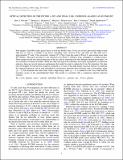| dc.contributor.author | Gentry, Eric S. | |
| dc.contributor.author | Hardcastle, Martin J. | |
| dc.contributor.author | Perlman, Eric S. | |
| dc.contributor.author | Birkinshaw, Mark | |
| dc.contributor.author | Worrall, Diana M. | |
| dc.contributor.author | Lenc, Emil | |
| dc.contributor.author | Siemiginowska, Aneta | |
| dc.contributor.author | Urry, C. Megan | |
| dc.contributor.author | Marshall, Herman | |
| dc.date.accessioned | 2015-09-03T17:43:08Z | |
| dc.date.available | 2015-09-03T17:43:08Z | |
| dc.date.issued | 2015-07 | |
| dc.date.submitted | 2015-05 | |
| dc.identifier.issn | 1538-4357 | |
| dc.identifier.issn | 0004-637X | |
| dc.identifier.uri | http://hdl.handle.net/1721.1/98358 | |
| dc.description.abstract | New images of the FR II radio galaxy Pictor A from the Hubble Space Telescope reveal a previously undiscovered tidal tail, as well as a number of jet knots coinciding with a known X-ray and radio jet. The tidal tail is approximately 5'' wide (3 kpc projected), starting 18'' (12 kpc) from the center of Pictor A, and extends more than 90'' (60 kpc). The knots are part of a jet observed to be about 4' (160 kpc) long, extending to a bright hotspot. These images are the first optical detections of this jet, and by extracting knot flux densities through three filters, we set constraints on emission models. While the radio and optical flux densities are usually explained by synchrotron emission, there are several emission mechanisms that might be used to explain the X-ray flux densities. Our data rule out Doppler-boosted inverse Compton scattering as a source of the high-energy emission. Instead, we find that the observed emission can be well described by synchrotron emission from electrons with a low-energy index (p ~ 2) that dominates the radio band, while a high-energy index (p ~ 3) is needed for the X-ray band and the transition occurs in the optical/infrared band. This model is consistent with a continuous electron injection scenario. | en_US |
| dc.language.iso | en_US | |
| dc.publisher | IOP Publishing | en_US |
| dc.relation.isversionof | http://dx.doi.org/10.1088/0004-637X/808/1/92 | en_US |
| dc.rights | Article is made available in accordance with the publisher's policy and may be subject to US copyright law. Please refer to the publisher's site for terms of use. | en_US |
| dc.source | IOP Publishing | en_US |
| dc.title | OPTICAL DETECTION OF THE PICTOR A JET AND TIDAL TAIL: EVIDENCE AGAINST AN IC/CMB JET | en_US |
| dc.type | Article | en_US |
| dc.identifier.citation | Gentry, Eric S., Herman L. Marshall, Martin J. Hardcastle, Eric S. Perlman, Mark Birkinshaw, Diana M. Worrall, Emil Lenc, Aneta Siemiginowska, and C. Megan Urry. “OPTICAL DETECTION OF THE PICTOR A JET AND TIDAL TAIL: EVIDENCE AGAINST AN IC/CMB JET.” The Astrophysical Journal 808, no. 1 (July 20, 2015): 92. © 2015 The American Astronomical Society | en_US |
| dc.contributor.department | MIT Kavli Institute for Astrophysics and Space Research | en_US |
| dc.contributor.mitauthor | Gentry, Eric S. | en_US |
| dc.contributor.mitauthor | Marshall, Herman Lee | en_US |
| dc.relation.journal | The Astrophysical Journal | en_US |
| dc.eprint.version | Final published version | en_US |
| dc.type.uri | http://purl.org/eprint/type/JournalArticle | en_US |
| eprint.status | http://purl.org/eprint/status/PeerReviewed | en_US |
| dspace.orderedauthors | Gentry, Eric S.; Marshall, Herman L.; Hardcastle, Martin J.; Perlman, Eric S.; Birkinshaw, Mark; Worrall, Diana M.; Lenc, Emil; Siemiginowska, Aneta; Urry, C. Megan | en_US |
| mit.license | PUBLISHER_POLICY | en_US |
| mit.metadata.status | Complete | |
